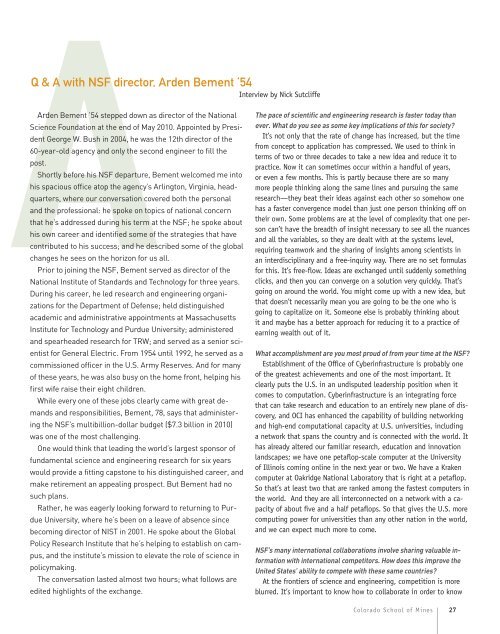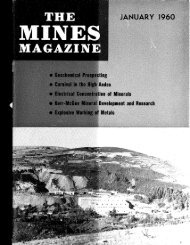Mines Magazine Turns 100 - the Timothy and Bernadette Marquez ...
Mines Magazine Turns 100 - the Timothy and Bernadette Marquez ...
Mines Magazine Turns 100 - the Timothy and Bernadette Marquez ...
- No tags were found...
Create successful ePaper yourself
Turn your PDF publications into a flip-book with our unique Google optimized e-Paper software.
Q & A with NSF director, Arden Bement ’54Interview by Nick SutcliffeArden Bement ’54 stepped down as director of <strong>the</strong> NationalScience Foundation at <strong>the</strong> end of May 2010. Appointed by PresidentGeorge W. Bush in 2004, he was <strong>the</strong> 12th director of <strong>the</strong>60-year-old agency <strong>and</strong> only <strong>the</strong> second engineer to fill <strong>the</strong>post.Shortly before his NSF departure, Bement welcomed me intohis spacious office atop <strong>the</strong> agency’s Arlington, Virginia, headquarters,where our conversation covered both <strong>the</strong> personal<strong>and</strong> <strong>the</strong> professional: he spoke on topics of national concernthat he’s addressed during his term at <strong>the</strong> NSF; he spoke abouthis own career <strong>and</strong> identified some of <strong>the</strong> strategies that havecontributed to his success; <strong>and</strong> he described some of <strong>the</strong> globalchanges he sees on <strong>the</strong> horizon for us all.Prior to joining <strong>the</strong> NSF, Bement served as director of <strong>the</strong>National Institute of St<strong>and</strong>ards <strong>and</strong> Technology for three years.During his career, he led research <strong>and</strong> engineering organizationsfor <strong>the</strong> Department of Defense; held distinguishedacademic <strong>and</strong> administrative appointments at MassachusettsInstitute for Technology <strong>and</strong> Purdue University; administered<strong>and</strong> spearheaded research for TRW; <strong>and</strong> served as a senior scientistfor General Electric. From 1954 until 1992, he served as acommissioned officer in <strong>the</strong> U.S. Army Reserves. And for manyof <strong>the</strong>se years, he was also busy on <strong>the</strong> home front, helping hisfirst wife raise <strong>the</strong>ir eight children.While every one of <strong>the</strong>se jobs clearly came with great dem<strong>and</strong>s<strong>and</strong> responsibilities, Bement, 78, says that administering<strong>the</strong> NSF’s multibillion-dollar budget ($7.3 billion in 2010)was one of <strong>the</strong> most challenging.One would think that leading <strong>the</strong> world’s largest sponsor offundamental science <strong>and</strong> engineering research for six yearswould provide a fitting capstone to his distinguished career, <strong>and</strong>make retirement an appealing prospect. But Bement had nosuch plans.Ra<strong>the</strong>r, he was eagerly looking forward to returning to PurdueUniversity, where he’s been on a leave of absence sincebecoming director of NIST in 2001. He spoke about <strong>the</strong> GlobalPolicy Research Institute that he’s helping to establish on campus,<strong>and</strong> <strong>the</strong> institute’s mission to elevate <strong>the</strong> role of science inpolicymaking.The conversation lasted almost two hours; what follows areedited highlights of <strong>the</strong> exchange.The pace of scientific <strong>and</strong> engineering research is faster today thanever. What do you see as some key implications of this for society?It’s not only that <strong>the</strong> rate of change has increased, but <strong>the</strong> timefrom concept to application has compressed. We used to think interms of two or three decades to take a new idea <strong>and</strong> reduce it topractice. Now it can sometimes occur within a h<strong>and</strong>ful of years,or even a few months. This is partly because <strong>the</strong>re are so manymore people thinking along <strong>the</strong> same lines <strong>and</strong> pursuing <strong>the</strong> sameresearch—<strong>the</strong>y beat <strong>the</strong>ir ideas against each o<strong>the</strong>r so somehow onehas a faster convergence model than just one person thinking off on<strong>the</strong>ir own. Some problems are at <strong>the</strong> level of complexity that one personcan’t have <strong>the</strong> breadth of insight necessary to see all <strong>the</strong> nuances<strong>and</strong> all <strong>the</strong> variables, so <strong>the</strong>y are dealt with at <strong>the</strong> systems level,requiring teamwork <strong>and</strong> <strong>the</strong> sharing of insights among scientists inan interdisciplinary <strong>and</strong> a free-inquiry way. There are no set formulasfor this. It’s free-flow. Ideas are exchanged until suddenly somethingclicks, <strong>and</strong> <strong>the</strong>n you can converge on a solution very quickly. That’sgoing on around <strong>the</strong> world. You might come up with a new idea, butthat doesn’t necessarily mean you are going to be <strong>the</strong> one who isgoing to capitalize on it. Someone else is probably thinking aboutit <strong>and</strong> maybe has a better approach for reducing it to a practice ofearning wealth out of it.What accomplishment are you most proud of from your time at <strong>the</strong> NSF?Establishment of <strong>the</strong> Office of Cyberinfrastructure is probably oneof <strong>the</strong> greatest achievements <strong>and</strong> one of <strong>the</strong> most important. Itclearly puts <strong>the</strong> U.S. in an undisputed leadership position when itcomes to computation. Cyberinfrastructure is an integrating forcethat can take research <strong>and</strong> education to an entirely new plane of discovery,<strong>and</strong> OCI has enhanced <strong>the</strong> capability of building networking<strong>and</strong> high-end computational capacity at U.S. universities, includinga network that spans <strong>the</strong> country <strong>and</strong> is connected with <strong>the</strong> world. Ithas already altered our familiar research, education <strong>and</strong> innovationl<strong>and</strong>scapes; we have one petaflop-scale computer at <strong>the</strong> Universityof Illinois coming online in <strong>the</strong> next year or two. We have a Krakencomputer at Oakridge National Laboratory that is right at a petaflop.So that’s at least two that are ranked among <strong>the</strong> fastest computers in<strong>the</strong> world. And <strong>the</strong>y are all interconnected on a network with a capacityof about five <strong>and</strong> a half petaflops. So that gives <strong>the</strong> U.S. morecomputing power for universities than any o<strong>the</strong>r nation in <strong>the</strong> world,<strong>and</strong> we can expect much more to come.NSF’s many international collaborations involve sharing valuable informationwith international competitors. How does this improve <strong>the</strong>United States’ ability to compete with <strong>the</strong>se same countries?At <strong>the</strong> frontiers of science <strong>and</strong> engineering, competition is moreblurred. It’s important to know how to collaborate in order to knowColorado School of <strong>Mines</strong> 27

















